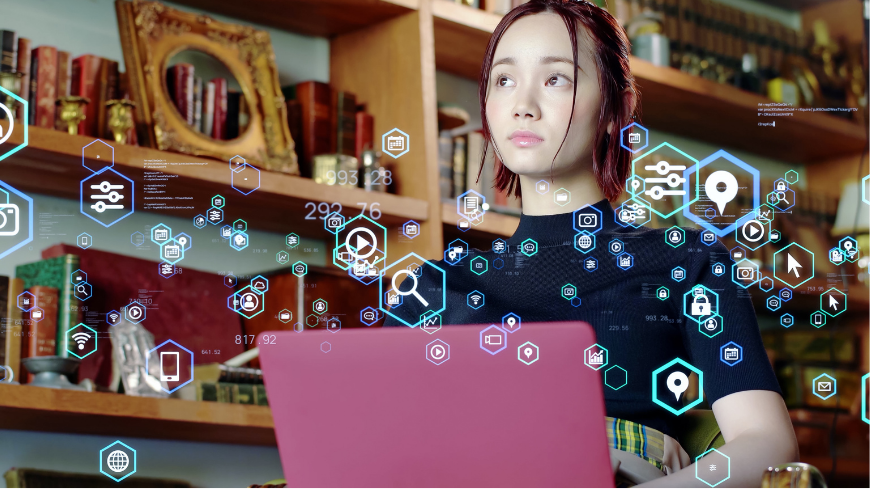As an EdTech company, Noodle Factory is a big proponent of AI in education. We’ve previously discussed how AI can change learning, onboarding, and even tutoring.
Today, we’re going back to the basics to give you a recap on what AI in education is, why it should or shouldn’t be used, and how you can use it.
Integrating AI Innovations in Education: Potential Uses and Challenges
Potential uses for AI in education
The uses for AI are endless because it can be incorporated into most online platforms to automate or enhance existing services.
Some of the most popular ways AI is used in education are:
1. On-demand, adaptive tutoring
AI can provide one-on-one tutoring through interactive dialogue, with no need for educators to be directly involved.
Not only does this save precious man-hours, but it also makes the learning experience for every student personalised.
Adaptive tutoring customises the learning path based on the students' progress, understanding, and competence in a subject. This allows learners to study at their own pace and focus on ideas that are the most challenging to them.
Educators can then focus on improving the curriculum and class content, while leaving it to the AI tutoring system to distribute the material.
2. AI-generated and -graded assessments
One of the most time-consuming tasks for educators is grading individual student assignments. With the use of AI, quizzes can be distributed and graded automatically.
This doesn’t just speed up the turnaround of taking and marking tests, but it also provides personalised feedback to students.
As Natural Language Processing (NLP) algorithms can now digest learning material in various formats such as slideshows, textbooks, and PDFs, educators can easily set up an online course curriculum before class starts.
Even though AI may not currently be able to grade long-form tests, it still offers lots of assistance to educators when it comes to short-answer tests and MCQ questions.
3. Learning analytics on students
An extremely useful application of AI in education is receiving learning analytics on students.
AI can provide educators with insights on student performance, engagement, and feedback. This helps educators and educational bodies to constantly better their curriculum and find new ways to best help learners.
Challenges for AI in education
High praise usually comes with its challenges, too.
1. Safeguarding privacy and managing the use of data
The rise of technology has brought on many online scams and problems with data protection.
AI in education also raises the privacy issue because the software has to process and store information in order to create personalised content and learning analytics.
This raises more questions such as where the information is stored, how long it is stored, who has access to the information, and so on.
2. Bias in AI
In an ideal world, AI is fiar and is not swayed by emotion. Although this should be the case now, we can’t hide from the fact that AI is manmade.
As such, there may have been biases from programmers or developers that have consciously or unconsciously been passed on to the AI too.
It’s hard to police AI to constantly ensure a lack of bias, so it is important to monitor AI activity and data to prevent bias as much as possible.
3. Negative implications of AI on educators and students
If all module content is given to learners through an AI platform, there is minimal human-to-human communication, taking away from personal connections.
And if AI does manage to create some connections, the increased efficiency may create less demand for educators.
The future of AI in education
1. Human-centred AI
This refers to AI that receives human input and collaboration to provide an effective learning experience between humans and AI.
By focusing on human behaviour, language, and emotions, AI can bridge the gap between the previously limited AI solutions and humans.
Human-centred AI increases informed decision-making, reliability and scalability, and software success.
2. More inclusive AI
Inclusivity with AI-based learning isn’t always easy as not every student may have access to the same tech tools.
While the use of AI can create a lack of inclusivity, it can also create a more inclusive space when used differently.
Organisations such as UNESCO are making it their mission to be more inclusive with the help of AI.
This can be done by analysing gaps and inequalities in order to prevent a wider divide and ensure equal opportunities for all learners.
3. Unsupervised machine learning
Unsupervised machine learning is when algorithms infer patterns from data, without any reference to known or labelled outcomes. This uncovers new patterns and makes supervised machine learning more relevant to real-life problems.
It is recommended to use unsupervised machine learning when you do not have data on the desired outcome, such as pinpointing a target market for a new product.
The bottom-line
There are countless uses, pros, and cons of using AI in education, and the future possibilities are also aplenty.
The fast-moving advancements of technology and AI will only continue to change the world of education.
If you want to learn more about the uses of AI in education, you’re in luck.
Noodle Factory has just launched our very own webinar series, Fireside Chat, which will be hosted by our co-founder and Chief Learning Officer, Jim Wagstaff. He will speak to thought leaders in the education and/or edtech industry on their views about AI in education.
Sign up for the webinar here!
Share or Read Our Other Articles Here.
